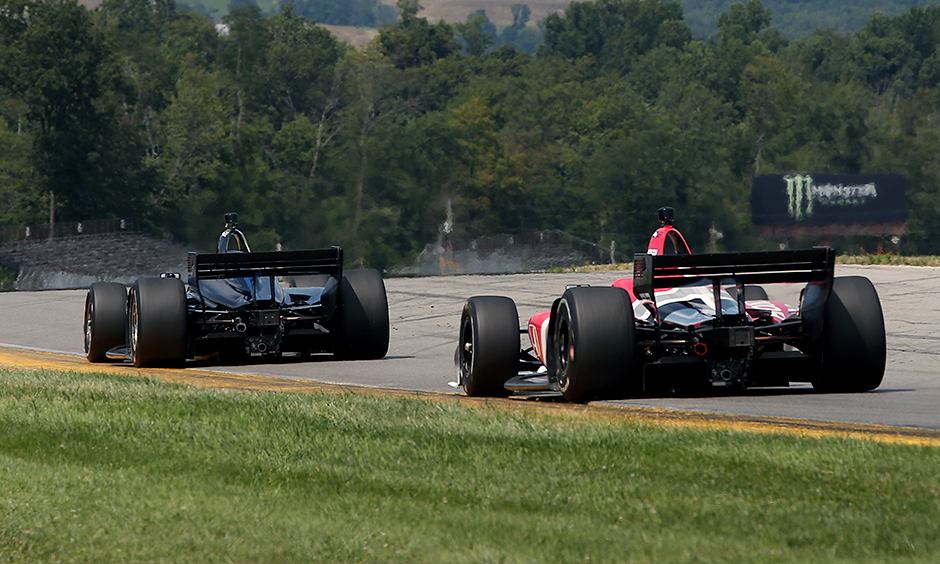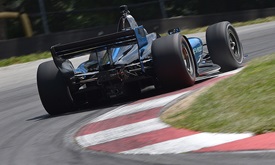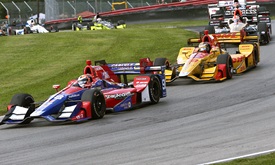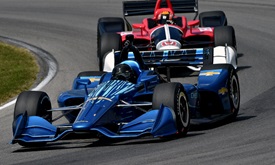Test drivers like exposed rear tires on universal aero kit
AUG 02, 2017
LEXINGTON, Ohio – On a sun-splashed day perfect for testing INDYCAR’s new universal aero kit, the lasting view for Juan Pablo Montoya wasn’t the scenic Mid-Ohio Sports Car Course. Rather, it was the sight of Oriol Servia’s car in front of him.
Tuesday’s test on the hills and curves of the 2.258-mile road circuit concluded with Montoya and Servia running in tandem to get a feel for how the new cars behave in traffic – particularly the trailing car. Driving the blue test car powered by a Chevrolet engine, Montoya was tucked behind the rear wing of Servia’s red, white and black Honda-powered machine and liked what he saw.
The new car’s look no longer has the rear wheel guards added during the current era of aero kit competition that ends after this season. Beauty is in the eye of the beholder and, for Montoya, the sight of Firestone’s large rear tires fully exposed is a masterpiece in motion.
“I was never a fan of the rear pods, to be honest,” Montoya said. “You have such a big rear tire that people forgot how good they look. Now you can see them and I think that’s good.”
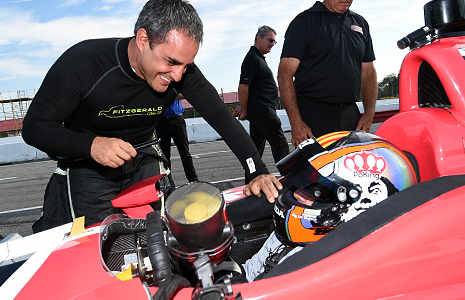 Moreover, the two-time Indianapolis 500 winner added, having a plain view of the leading car’s rear tires aids the driver behind in gauging how well that car is performing – and when the opportunity to pass might present itself.
Moreover, the two-time Indianapolis 500 winner added, having a plain view of the leading car’s rear tires aids the driver behind in gauging how well that car is performing – and when the opportunity to pass might present itself.
“Seeing the rear tires again was very different,” Montoya said. “I think we were so used to not seeing the rear tires that, when you follow somebody (without the wheel guards), you see the tracks and when they spin the tires. You’re more aware of what’s going on around you.”
Of course, that’s just be an ancillary benefit of removing the wheel guards from the universal kit that will be used by all competitors in the 2018 Verizon IndyCar Series. A primary reason for their removal was to shift the car’s weight balance forward to make it handle better.
That was proven in Tuesday’s test, the first for the universal kit configuration to be used on all road courses, street courses and short ovals next season. The superspeedway oval configuration, successfully tested at Indianapolis on July 25, no longer has the rear wheel guards, either.
“It just feels good not having the rear bumpers,” said Servia. “We realize now how much it really hurt the behavior of the car before. Not only was there the bumper, but we kept adding a thousand (aero kit) winglets on top, so you had all that weight behind the rear wheel and it made the car behave not the most natural. It feels a lot more natural now and it’s fun.”
The added bodywork and winglets on the current car’s rear also cause more air disturbance in its wake, making it more difficult for approaching cars to run up close and pass. The universal kit has fewer pieces on top to disturb air, with most of the downforce generated from underneath the car.
“If the downforce comes from the bottom of the floor, then that’s a lot less effected (turbulent air in the wake),” Servia explained. “On ovals especially, you should be able to follow cars a lot more closely.”
The new car generates less overall downforce than the current car, which makes them slide more on track and put even more emphasis on driver ability. Montoya cited driving over one of Mid-Ohio’s blind corners as an example.
“Things that used to be a gimme, with this (new car), it’s like, ‘Oh, my God!’” he said. “Going over the crest in the back, you’re spinning the tires, you’re sideways through there.
“You can really tell the power more with this lighter downforce. You can get in trouble easier.”
That’s music to the drivers’ ears. Make the car tougher to drive and the competition becomes better. And the fans will love it.
“The cars look great, they’re fun to drive and the cars are going to move more,” Servia concluded. “Which, at the end of the day, the fans like seeing.”










